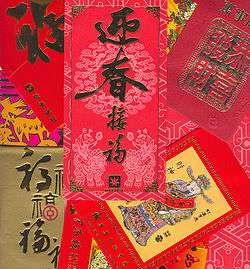Color in Chinese culture

Color in Chinese culture refers to the certain values that Chinese culture attaches to colors, like which colors are considered auspicious (吉利) or inauspicious (不利). The Chinese word for "color" is yánsè (顏色). In Classical Chinese, the character sè (色) more accurately meant "color in the face", or "emotion". It was generally used alone and often implied sexual desire or desirability. During the Tang Dynasty, the word yánsè came to mean all color. A Chinese idiom which is used to describe many colors, Wǔyánliùsè (五颜六色), can also mean colors in general.
Theory of the Five Elements
In traditional Chinese art and culture, black, red, qing (青) (a conflation of the idea of green and blue sometimes called "grue"), white and yellow are viewed as standard colors. These colors correspond to the five elements of water, fire, wood, metal and earth, taught in traditional Chinese physics. Throughout the Shang, Tang, Zhou and Qin dynasties, China's emperors used the Theory of the Five Elements to select colors.
| Element | Wood | Fire | Earth | Metal | Water |
|---|---|---|---|---|---|
| Color | Green | Red | Yellow | White | Black |
| Direction | east | south | center | west | north |
| Planet | Jupiter | Mars | Saturn | Venus | Mercury |
| Heavenly creature | Azure Dragon 青龍 | Vermilion Bird 朱雀 | Yellow Dragon 黃龍 | White Tiger 白虎 | Black Tortoise 玄武 |
| Heavenly Stems | 甲, 乙 | 丙, 丁 | 戊, 己 | 庚, 辛 | 壬, 癸 |
| Phase | New Yang | Full Yang | Yin/Yang balance | New Yin | Full Yin |
| Energy | Generative | Expansive | Stabilizing | Contracting | Conserving |
| Season | Spring | Summer | Change of seasons (Every third month) | Autumn | Winter |
| Climate | Windy | Hot | Damp | Dry | Cold |
| Development | Sprouting | Blooming | Ripening | Withering | Dormant |
| Livestock | dog | sheep/goat | cattle | chicken | pig |
| Fruit | plum | apricot | jujube | peach | chestnut |
| Grain | wheat | beans | rice | hemp | millet |
Black
Black, corresponding to water, is a neutral color. The I Ching, or Book of Changes, regards black as Heaven's color. The saying “heaven and earth of mysterious black” was rooted in the observation that the northern sky was black for a long time. They believed Tian Di, or Heavenly Emperor, resided in the North Star.
The Taiji symbol uses black and white to represent the unity of Yin and Yang. Ancient Chinese regarded black as the king of colors and honored black more consistently than any other color. Lao Zi said that five colors make people blind, so the Dao School chose black as the color of the Dao.
In modern China, black is used in daily clothing. White is associated with death and mourning and was formerly worn at funerals, but depends on the age of passing.
Red

Red, corresponding with fire, symbolizes good fortune and joy. Red is found everywhere during Chinese New Year and other holidays and family gatherings. A red envelope is a monetary gift which is given in Chinese society during holiday or special occasions. The red color of the packet symbolizes good luck. Red is strictly forbidden at funerals as it is a traditionally symbolic color of happiness;[1] however, as the names of the dead were previously written in red, it may be considered offensive to use red ink for Chinese names in contexts other than official seals.
In modern China, red remains a very popular color and is affiliated with and used by the Government.
Green
Generally green is associated with health, prosperity, and harmony. Separately, green hats are associated with infidelity and used as an idiom for a cuckold.[2] This has caused uneasiness for Chinese Catholic bishops, who in ecclesiastical heraldry would normally have a green hat above their arms. Chinese bishops have compromised by using a violet hat for their coat of arms. Sometimes this hat will have an indigo feather to further display their disdain for the color green.
White
White, corresponding with metal, represents gold and symbolizes brightness, purity, and fulfillment. White is also the color of mourning. It is associated with death and is used predominantly in funerals in Chinese culture.[3] Ancient Chinese people wore white clothes and hats only when they mourned for the dead.
Yellow
Yellow, corresponding with earth, is considered the most beautiful and prestigious color. The Chinese saying, Yellow generates Yin and Yang, implies that yellow is the center of everything. Associated with but ranked above brown, yellow signifies neutrality and good luck. Yellow is sometimes paired with red in place of gold.
Yellow was the emperor's colour in Imperial China and is held as the symbolic color of the five legendary emperors of ancient China. Yellow often decorates royal palaces, altars and temples, and the color was used in the robes and attire of the emperors.
Yellow also represents freedom from worldly cares and is thus esteemed in Buddhism. Monks' garments are yellow, as are elements of Buddhist temples. Yellow is also used as a mourning color for Chinese Buddhists.
Yellow is also symbolic of heroism, as opposed to the American association of the colour with cowardice.[3]
See also
- Chinese art
- Culture of China
- Culture of the People's Republic of China
- Fashion of China
- Luck
- Numbers in Chinese culture
References
- ↑ see Funeral#Funerals in East Asia
- ↑ Norine Dresser, Multicultural Manners: New Rules of Etiquette for a Changing Society, ISBN 0-471-11819-2, 1996, page 67
- 1 2 Psychology of Color: Does a specific color indicate a specific emotion? By Steve Hullfish | July 19, 2012